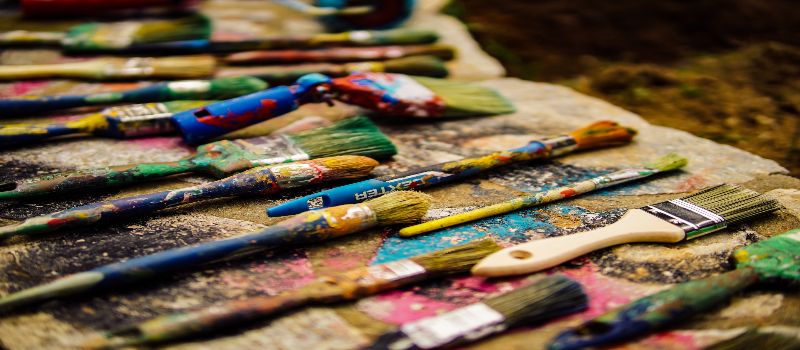Let’s jump into the acrylic vs latex paint debate. Here’s everything you need to know…
First, there are many paint types out there.
It’s, therefore, crucial to balance taste and substrate compatibility before purchasing paint.
To get this right, you need to know the paints or have some background information.
As I’ve indicated earlier in this article, I’ll look at acrylic vs latex paint.
The paints are the same in some aspects and differ in others.
The similarities revolve around their solvent base, shelf lives, thinning agents, additives, etc.
The differences are based on their uses, weather resistance, durability, cost, coverage, adhesive properties, etc.
I’ll give a detailed analysis of the above and the pros and cons of both paints.
The article also contains information on the following:
- Whether it’s possible to mix latex with acrylic paint
- The reasons painters use acrylic paint
- Top-grade acrylic paints
- First-rate latex paints
However, I’ll start by comprehensively defining acrylic paint, followed by latex paint.
It will gear you up to better understand the subsequent segments.
I encourage you to read it wholly and attentively for maximum benefit. Let’s get the ball rolling.
What Is Acrylic Paint?
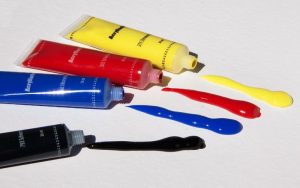 A good paint job is more than meets the eye.
A good paint job is more than meets the eye.
It’s the culmination of using the most appropriate paint, sufficient priming, proper painting techniques, and top-quality application tools.
This segment focuses on enlightening you on one of the best paints for every project, i.e., acrylic paint. So, what is acrylic paint?
It is a quick-drying paint comprising pigments dispersed in acrylic polymer emulsion and stabilizers, defoamers, plasticizers, metal soaps, and silicone oils.
Most acrylics are waterborne, so you can thin them and wash spills off using water.
However, the paint becomes water-resistant when dry, an integral quality that has led to its successful use as a coating agent.
An acrylic finish can resemble a gouache, a watercolor, or an oil painting or have distinctive characteristics unattainable with other media.
It depends on the degree of dilution with water or modification with acrylic mediums, gels, or pastes.
Regarding its history, acrylic resin dispersion was first used in 1934 by BASF, a German chemical company.
The synthetic version saw its first use in the 1940s, and it blended the properties of watercolor and oil paints.
Over time, acrylics have undergone several tweaks to form the modern-day version discussed in this article.
Types of Acrylic Paint
Industrial acrylics come in two grades:
- Professional/Artist acrylics: These are designed to withstand chemical reactions due to exposure to oxygen, water, and UV rays.
Artist-grade acrylics have high amounts of pigments for better medium manipulation and minimal color shift when you mix with other colors and after drying.
- Student acrylics: These are less expensive formulas with lower pigment proportions and fewer obtainable colors than their professional-grade counterparts.
The rest of their features are similar.
Varieties
- Heavy body acrylics: These are typical of professional and student-grade paints.
“Heavy body” alludes to the thickness or viscosity of the paint.
They are ideal for impasto painting technique and can retain brush strokes, painting knife strokes, and even medium stiff peaks.
Moreover, you can use acrylic gel mediums to thicken the above paints further, extend them, and make them more transparent.
Examples of heavy body acrylics are Lukas Pastos Acrylics, Golden Heavy Body Acrylics, Matisse Structure Acrylic Colors, and Liquitex Heavy Body Acrylics.
- Open acrylics: These paints are formulated with hydrophilic acrylic resins and other chemicals that lengthen their drying time to match oil paints.
Their drying times range from hours to days depending on the constituents, paint thickness, relative humidity, and temperature.
Golden Artist Colors Inc makes open acrylics.
- Medium viscosity acrylics: are also called soft body acrylics, high-flow acrylics, or fluid acrylics.
They have the same pigmentation but lower viscosity than the heavy body variety.
The cost and quality of these paints vary as they come in either craft or artist or craft quality.
The paints are perfect for airbrush application, watercolor techniques, or when you desire smooth coverage.
You can mix soft body acrylics with any medium to make them thicker for impasto painting. You can also thin them to make glazes.
Examples of high-flow acrylics are Liquitex Soft Body, Lukascryl Studio, Lucascryl Liquid, and Golden Fluid acrylics.
- Interactive Acrylics: These are multipurpose acrylic artists’ colors with the typical quick-drying attribute.
However, they are designed to allow the user to delay the drying for more working time and to blend in other colors.
- Craft acrylics: They are used on surfaces in addition to canvas. Such surfaces include metal, wood, ceramics, and fabrics.
The paints are ideal for faux finishing and decorative painting.
Craft paints often use PVA resins or vinyl to improve adhesion and reduce costs.
Even though you can mix colors, the pigments are usually unspecified; instead, we formulate each color line to attain a variety of premixed colors.
- Iridescent, pearl, and interference acrylic paints: combine ordinary pigments with pulverized aluminum silicate (mica) or powdered bronze to produce enthralling visual effects.
The colors have different degrees of reflective or glistening characteristics depending on the fineness or coarseness of the powder.
Iridescent colors are employed mainly in crafts and fine arts.
- Acrylic enamel paint: These acrylics create a stiff but smooth shell over surfaces; you can air dry or bake it in an oven.
The paint sticks to surfaces permanently if you keep the painted material away from damaging conditions like continual physical stress and weather extremes.
- Exterior acrylics: These paints can tolerate outdoor/environmental conditions.
They, like craft acrylics, adhere to various surfaces; however, they have better resistance to UV rays and water.
Therefore, they are the best for outdoor signs, architectural murals, and exterior faux-finished substrates.
- Acrylic gouache: this is similar to traditional gouache as it dries to an opaque, matte finish.
But, unlike ordinary gouache, the acrylic binder confers water resistance to the above paint upon drying.
The paint is popular with illustrators, watercolorists, cartoonists, and folk art or decorative applications.
Like craft paint, it adheres to other surfaces besides paper and canvas.
Examples are Turner Acryl Gouache and Lascaux Gouache.
- Acrylic glass paint: This is waterborne and semi-permanent, making it appropriate for exhibition on glass windows.
Their temporary nature makes them easy to remove once you’re done displaying.
Pros and Cons of Acrylic Paints
Acrylic paints have their advantages and shortcomings. In this segment, I’ll outline the pros and cons of acrylic paints.
It’s also important to note that all the other paints have upsides and downsides; that’s pretty normal for human inventions.
The real test lies in whether the advantages outweigh the disadvantages or the other way round.
For acrylics, the advantages dominate over the faults.
Pros
- The paints are easy to apply
- They won’t yellow with time; this maintains your work’s color and decorative appeal.
- The paints dry fast to enable you to finish your project quickly
- Acrylic paints contain minimal VOC levels, so they are safe for both humans and the environment
- Premium enamel acrylics have a similar durability profile to oil paints
- It’s easy to clean up after using acrylic paints; all you need is soap and water, or warm soapy water for tough stains
- The colors retail at budget-friendly costs
- You can dilute or thin acrylic paints with water, which is cheaper and more accessible than turps and mineral spirits.
Cons
- Broadly, acrylics are less durable than oil paints.
- These paints have inferior leveling properties compared to oil paints; it predisposes them to brushmarks.
- Their short drying times compel you to work fast. Therefore, making corrections or working one color into another is challenging.
What Is Latex Paint?
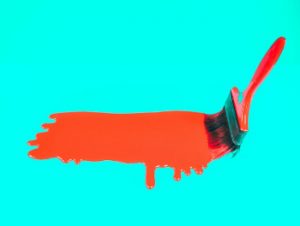 In this part, I’ll take a close-up look at latex paint, including its pros and cons.
In this part, I’ll take a close-up look at latex paint, including its pros and cons.
It’s essential to know both paints inside-out so you can navigate smoothly through the rest of the article.
It’ll also help you make the best decision before purchasing. Without further ado, what is latex paint?
In the most basic terms, latex paint is a dispersion of polymer particles in the water alongside pigments and additives.
In more scientific parlance, latex is an emulsion that stiffens/solidifies on exposure to air.
It comprises resins, alkaloids, tannins, proteins, sugars, gums, oils, and starches.
Originally, latex paint was made from natural latex obtained from some flowering plants.
Over time, this sourcing method became expensive and unsustainable as it involved waiting for the plants to grow, harvesting, and isolating specific ingredients.
It necessitated sourcing from synthetic/artificial alternatives.
Over 80% of latex paint is made from synthetic monomers, i.e., styrene, n-butyl acrylate, ethylene, and butadiene.
The said monomers are combined with pigments and additives to make functional paint.
The water component evaporates upon application to the appropriate substrate while the polymers and pigment coalesce to form a solid, protective film.
The other components have far higher boiling points than water, so only the water evaporates.
The evaporation ensures no toxic materials are released into the environment.
Pros and Cons of Latex Paints
As I’ve done with acrylics above, I’ll dedicate this part of the article to the pros and cons of latex paints.
Knowing the advantages and disadvantages guides you on what to expect from the paint and whether it is compatible with the substrate.
Pros
- It is less expensive than acrylic paint
- Latex paints don’t peel or crack easily
- It enables the substrate to “breathe” to let out trapped moisture
- The paints dry super quick to fast-track project completion
- These paints don’t yellow with age as oil paints do
- They are waterborne, so you can thin and clean up with water
- Latex paint is non-flammable and contains no VOCs, so it’s safe for use on kitchen materials
- Most of them are odorless, making them comfortable to work with
Cons
- They are not as durable as acrylic and oil paints
- Most need priming before application
- It’s not the best option for high-traffic substrates.
What Is Acrylic Latex Paint?
We’ve looked at acrylic and latex paints separately.
However, you’ll find that there are products named acrylic latex on the market.
So, what is acrylic latex paint? It often confuses potential buyers who may gamble on the purchase or opt out.
This segment aims to clarify the matter concisely.
Just as the name sounds, Acrylic latex is a formulation comprising acrylic and latex paint.
It’s made through copolymerization, whereby acrylic monomers (polyacrylate) are crosslinked with latex monomers (styrenes or isoprenes).
The resulting formula exhibits traits from the two paints in one package.
The latex component of the mixture contributes the following properties:
- It reduces the paint’s VOC levels, making it less toxic to humans and more environmentally friendly.
- It makes the product more affordable: latex paint monomers are synthetically made, so they are widely available and cheap. Low production costs translate to pocket-friendly selling prices.
- It pacifies the strong odor typical of pure acrylic paint.
- The blending makes the final product easy to use.
The acrylic paint component of the product contributes these qualities:
- Durability: the polyacrylate polymers form a hard film upon drying. It imparts durability to both paint and the underlying substrate.
- Coverage: acrylic covers more surface area than latex, so combining the two significantly improves the coverage of the resulting paint.
- Adhesion: it forms tighter and firmer bonds with the substrate so the paint won’t peel off easily
- Weather endurance: improves the paint’s tolerance to harsh weather conditions and damaging environmental elements.
Overall, acrylic latex paint is a hybrid of the two paints to make its use adaptable to various situations.
You can use it on outdoor and indoor surfaces and materials like metals, plastics, masonry, wood, etc.
Acrylic Vs Latex Paint
This section constitutes the core of the article.
Here, I’ll present acrylic vs. latex paint in terms of their weather resistance, durability, coverage, curing time, adhesion, etc.
The paints have similarities and differences. I’ll start with the similarities. They are based on:
Solvent/Vehicle
Both acrylic and latex paints use water as the principal solvent.
The solvent forms the continuous or liquid phase of paint, where the acrylic and latex paint components are suspended.
Water gives acrylic and latex paints flow properties, makes them easy to apply, and holds all the constituents together, forming one functional unit.
The solvent also functions as the thinning agent for both paints. Thinning agents improve the flow properties of paint.
If your acrylic or latex paint is too thick, add water to dilute it; if it’s too runny, add more paint to make it viscous.
Additives
Additives are adjunct substances added to paint to improve their performance and efficacy.
Most latex and acrylic additives are the same. They include:
Biocides: these are mainly fungicides, bacteriocides, and vermicides.
They prevent fungal growth, bacterial decomposition, and substrate destruction by rodents. Examples are barium metaborate, tributyltin oxide, and zinc oxide.
Paint Conditioners: Floetrol is the principal conditioning agent for both paints. It improves their flow and usability.
Dispersants are low molecular weight substances added to paint to prevent clumping/agglomeration of suspended constituents.
It does so by making the particles repel each other. Examples include polyvinyl pyrrolidone, sodium dodecyl sulfonate, and polyacrylate salts.
Corrosion inhibitors: prevent rusting and other forms of chemical degradation of, especially, metallic substrates.
They include aluminum flake, barium chromate, calcium borosilicate, etc.
Catalysts: They accelerate polymer crosslinking and reduce drying and curing temperature and time.
It leads to faster film formation. Examples are lead octate and carbodiimides.
Emulsifiers: facilitate the mixing of the immiscible components of paint by increasing their kinetic stability.
Adhesion promoters: are bi-functional substances that increase the bonding power between the paint and the substrate.
They include organofunctional silanes, organometallic compounds, chlorinated polyolefins, and silicone-modified polymers.
Texturizers: impart character or a grainy feel to paints; this improves their tactile quality. It’s good for impasto painting.
The most commonly used agent is finely-ground silica dioxide.
If the grip isn’t enough, you can add acrylic or latex texture gels and mediums.
The major manufacturing brands are Winsor & Newton, Liquitex, and Pebeo.
That’s how far the similarities between the two paints go. Next, we look at the differences, and these are the points of reference:
Durability
Acrylic paint is more durable than latex paint because of its hard-wearing characteristics.
However, if you use both paints on suitable substrates, they are all durable.
Since acrylic is more tolerant to physical stress, scratching, and frictional force, it’s more suited for high-traffic substrates and exterior applications.
The above statement doesn’t mean latex paint isn’t durable.
As I’ve intimated, you need to use it on the appropriate material to benefit from its longevity.
Moreover, latex paints specially formulated for exterior use; these have a similar durability profile to acrylics.
Coverage
Acrylic paint has slightly better surface coverage than latex.
So if you buy identical amounts of both paints, the acrylic will see you further through the project than latex paint.
However, premium latex paints have better coverage than some acrylic paints; predictably, they cost more.
Also, acrylic paints will make do without primers; latex paints don’t fare quite well under similar circumstances.
The takeaway from the above is if you’re working on an extensive project, especially outdoors, use acrylic paint instead of latex.
The superior coverage will notch up your painting experience and save you some time.
Weather Resistance
Acrylic paint can withstand more harsh/extreme weather conditions than latex.
Note that the evaluation of weather tolerance is not only based on specific extreme conditions but also fluctuations.
For instance, the weather could be rainy for a few weeks, then extremely sunny in the subsequent weeks; it could also oscillate between high humidity and low humidity.
Exposing a latex-painted material to such conditions makes it prone to wear, fading, and peeling.
While acrylic is the better of the two paints in the above scenario, it is not the best.
Oil-based paints rank first in weather resistance, hard-wearing qualities, and UV tolerance, though the aesthetics are seriously undermined.
Adhesion
Adhesion, in this context, means the bonding power of paint to surfaces. Again, acrylic paint has a slight edge on latex in this regard.
Consequently, you can apply acrylic paint without using a primer.
But this doesn’t completely disregard the need for a primer for acrylics; substrates like plastic, glasses, and some lumber have very smooth surfaces.
Therefore, they will need priming, even when using acrylic paint.
On the other hand, latex paints need priming more often than not; it makes them stick better to surfaces.
Even so, top brand latex paints have an almost identical clinging power to acrylics.
Drying Time
Both paints have short drying times because they are water-based. The dry time range for recoating is 4 to 6 hours.
However, acrylic paint is on the lower limit side of the range, while latex paint falls closer to the upper limit.
In a nutshell, acrylic paint takes a slightly shorter duration to dry than latex.
Although there’s a difference in the drying times, it is so small that it will quickly go unnoticed if you are working on a small project.
The difference becomes discernible if the project is large, like those on an industrial scale.
In such a setting, and you’re pressed for time, I urge you to go for acrylic paint.
But if you only have latex paint and no immediate access to acrylics, I advise you to do the following to speed up drying:
- Add paint thinner.
- Add paint drying accelerator or paint mediums.
- Use electric fans to expedite evaporation.
- Heat the painted surface to facilitate solvents loss.
Ease of Use
We often gauge a paint’s ease of use on two parameters, i.e., application and cleanup.
Both acrylic and latex paints are easy to use and far more straightforward than all oil-based paints. It’s because they are waterborne.
But if we take a close-up analysis of the paints in question, latex paints are easier to use than acrylics.
Regarding application, latex is easy to use because of its constituents.
It comprises styrene monomers which are relatively easy to manipulate when dissolved in water.
On the other hand, acrylic paints consist of acrylate monomers, which are more challenging to handle but form stronger films.
Likewise, it’s easier to clean up accidental spills and painting equipment when working with latex.
Acrylic paint attaches more firmly to surfaces, so its removal is equally demanding.
Aside from the above aspects, the ease of use depends on the type of substrate and adherence to painting protocols.
On substrate type, excessively porous materials and very smooth surfaces make paint use arduous.
The porous material absorbs paint, while the smooth surface can’t grip or hold the paint.
The point I’m trying to drive home is that the usability of both paints can be dynamic at times.
Cost and Availability
Both paint retail at affordable prices thanks to technological advancements in sourcing raw materials and continual refinement of production methods.
A head-to-head comparison of the two paints ranks acrylics marginally above latex paints in costs.
Latex is cheaper because most of it is synthesized, and the main building blocks (styrene butadiene and amino aldehyde resins) cost less.
Acrylic paint comes at a higher price because starting material (acrylates) costs more.
On the contrary, natural latex makes more expensive latex paint because the naturally-sourced constituent is more stretchy and has better mechanical strength.
It improves the paint’s quality.
Regarding availability, latex paints are more widespread than acrylics.
It’s because most latex paints are artificially made, and the raw materials are readily available and accessible.
Also, you can make latex paint by crosslinking different monomers, a process known as copolymerization.
It reduces production costs to make budget-friendly products.
Can You Mix Acrylic and Latex Paint?
Sometimes you may want a blend of characteristics from two or more paints.
Blending is a gray area that painting professionals and homeowners find challenging to figure out.
How about combining the two paints? And in our case, can you mix acrylic and latex paint?
You can because both of them use water as the vehicle/solvent.
However, if you have to use the two paints as a homogeneous mixture, I advise you to purchase an already mixed formula, i.e., factory-mixed acrylic and latex paint.
The manufacturers are often heavily invested in developing the proper formulation of both paints to avoid miscibility problems.
Remember, acrylic and latex paints contain many ingredients and adjunctive substances like preservatives, stabilizers, colorants, catalysts, etc.
While the major components may mix easily, the additives may react with each other to degrade the paint and undermine its usability.
A factory-mixed acrylic and latex paint considers all of the above factors to make the perfect latex/acrylic paint.
Mixing separately-bought acrylic and latex is often a gamble; it may or may not succeed.
Are you willing to risk losing both paints with a 50/50 chance of success? I don’t think so.
You can mix the paints, but the best option is to get an already mixed one from the market.
Why Do Painters Use Acrylic Paint?
Acrylic paints are ubiquitous in the painting world.
Professionals, amateurs, students, and DIYers all have positive feedback on the paint in question.
It begs the question, why do painters use acrylic paint?
Many painters like using acrylics for the following reasons:
Versatility
Acrylic is an all-rounded paint that works perfectly on most substrates!
It goes on wood, metals, plastics, glass, ceramics, etc. In short, it is a universal paint.
The above makes it easy to coat different materials with the same paint.
You can use one or two cans of acrylic on cabinets, tables, beds, and even floors. It saves money and time.
Affordability
Though it may rank lower than latex paint on this index, acrylic paint is more affordable than other paints.
The affordability is not limited to purchasing costs, which is already convenient; it also pertains to paint coverage.
Acrylics have excellent surface coverage, so a small amount of paint goes a long way.
It economizes paint, further doubling down on the affordability point.
Also, you don’t need complicated or expensive painting equipment to apply acrylics; an ordinary paintbrush or a spray gun will do.
All you have to do is follow the outlined procedures and use the proper techniques. Don’t go for substandard tools, though.
Easy to Work With
It’s easy to handle acrylic paint for the simple fact that it is water-based.
The water solvent makes it easy to apply and lowers the viscosity (thinning) when the paint is too thick.
The paint comes off easily when you clean accidental spills and application tools with water.
However, the secret to a perfect cleanup is doing it when the paint is still wet or fresh; if you let it dry, it won’t come out.
Quick Drying
Acrylic paint has short drying times following application.
It becomes touch dry after 30 minutes and dry for recoating in 4 to 6 hours.
It is convenient compared to oil-based paints, which take around 24 hours to be ready for recoating.
That said, using acrylic paint fast-tracks the project for timely completion.
It Is Durable
Acrylic paint has an excellent longevity profile thanks to its hard-wearing, trauma resistance, and stretch properties.
It lasts for over ten years on high-traffic substrates, so it makes sense why it would be a painter’s favorite.
Acrylic paint can also be formulated with fire-resistant chemicals to make them intumescent.
It bolsters its protective characteristics.
Fade Resistant
One of the most impressive qualities of acrylic paint is the ability to maintain its color throughout its lifetime.
It preserves your substrate’s new look and visual appeal, which is every painter’s dream.
Furthermore, the paint in question doesn’t yellow over time, even when frequently exposed to sunlight.
Weather Resistance
Another reason homeowners, painting professionals, and DIY enthusiasts like using acrylic paint is it can withstand severe weather conditions.
The paint will still hold up, whether it is extreme sunlight, wind, excessive rain, high humidity, or a constant shift throughout the variables.
Decorative Property
Another likable feature of acrylic relates to aesthetics.
The paint comes in countless colors and sheens to achieve different but equally attractive finishing.
Also, textured versions of the paint impart a granular, discernible appeal to your substrate.
Best Acrylic Paints
Many companies manufacture acrylic paints; some make top-grade products while others make substandard commodities.
This section will give brief accounts of the best acrylic paints.
These are the products:
1. DecoArt Americana Decor Satin Enamels Acrylic Paint
DecoArt has been a distinguished acrylic paint manufacturer since 1985 and sells in over 60 countries worldwide.
One of its best products is the Americana Decor Satin Enamel, meant for wooden substrates like household furniture, baseboards, kitchen cabinets, patios, and doors.
 The paint mentioned above is usually purchased with the Golden Acryl Med 32 Oz Gac-800, which imparts anti-crazing properties.
The paint mentioned above is usually purchased with the Golden Acryl Med 32 Oz Gac-800, which imparts anti-crazing properties.
Adding the Gac-800 to Decor Satin Enamel Acrylic enables the paint to dry evenly and smoothly, with moderate clarity and an eye-catching gloss.
More attributes and advantages of the DecoArt acrylic paint include:
- It’s well-formulated for a straightforward application that requires minimal brushstrokes
- The paint is available in 21 color shades. You can still mix these colors to come up with unique finishes
- One jar of DecoArt satin enamels paint has broad two-coat coverage of 20 sq ft
- This paint is waterborne, so it’s non-toxic to the environment and humans
- You only need soap and water to clean up accidental spills, and the painting tools
- This paint minimizes wood grain raising
2. Acrylic Paint Set, Caliart 52 Vivid Colors
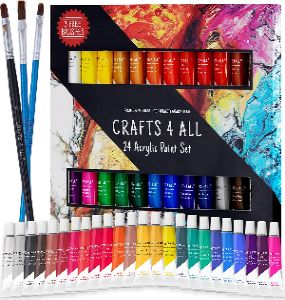 The above paint is made from first-grade raw materials and is available in 52 colors, including four metallics.
The above paint is made from first-grade raw materials and is available in 52 colors, including four metallics.
The paint works perfectly on ceramics, wood, canvas, and fabric.
It is designed for use across all demographics, i.e., adults, teens, and children.
You can use it for student practice, professional, and DIY projects.
The colors are packed in a well-organized manner inside a box for the convenience of telling them apart.
Other remarkable features of the Caliart acrylic paint set are:
- It has a magnificent viscosity profile that enables you to build texture and add more details
- The broad range of combinable colors creates room for imagination to contrive additional color schemes
- It’s water-based, therefore easy to lay down and clean up after use
- The paint is eco-friendly
- You can improve its flow properties by simply adding water
- The rich pigmentation gives it excellent surface coverage and decorative properties
- The paint is budget-friendly
3. KILZ Over Armor Textured Wood & Concrete Resurfacer
Masco Corporation owns the above product.
It’s a conglomerate that comprises over 20 companies in the United States and many other countries.
Their headquarters are in Livonia, Michigan, US.
Masco’s segments and businesses entail cabinetry, plumbing, decorative architecture, and many miscellaneous specialty products.
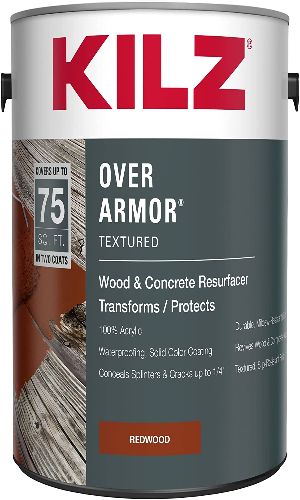 The KILZ textured wood & concrete resurfacer falls under the company’s decorative and architectural products subsection.
The KILZ textured wood & concrete resurfacer falls under the company’s decorative and architectural products subsection.
Melvin Caldwell introduced the KILZ brand in 1974 at a national paint show.
Since then, it has seen an inextinguishable soar to prominence in the painting world.
The above-named textured wood and concrete coating has these conveniences and attributes:
- The paint is available in 1-gallon (128 fl oz) cans
- The textured finish bridge cracks and conceals other imperfections
- This paint is 100% acrylic, so it’s hard-wearing and durable
- It’s mildew and mold resistant
- KILZ textured wood resurfacer is slip-resistant
- It has surface coverage of 70 sq feet per gallon
Best Latex Paints
Like acrylic paints, several companies make latex paints. Again, there are top-level products and third-rate ones.
I’ve combed through the mess to single out the best latex paints. Here is the shortlist:
1. Rust-Oleum 197630 Painter’s Touch Latex Paint
The above product belongs to the Painter’s Touch brand of Rust-Oleum®, which is in turn owned by RPM International Inc.
The painter’s touch is acclaimed for giving decorative appeal to homes and offices.
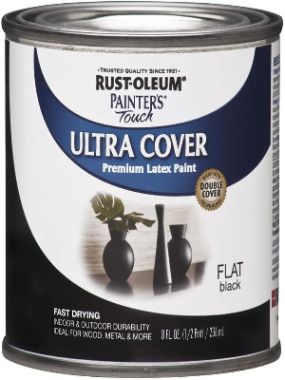 Its acquisition by Rust-Oleum, and ultimately RPM International, has raised its paint standing to the global level.
Its acquisition by Rust-Oleum, and ultimately RPM International, has raised its paint standing to the global level.
The latex paint named above has the following benefits and features:
- It comes in 8 fl oz containers.
- The paint is ideal for indoor and outdoor surfaces, including metal, wood, masonry, and ceramics.
- This paint has broad surface coverage of 30 square feet per container
- Rust-Oleum 197630 latex paint dries fast for timely project completion
- It comes in a variety of colors and sheens
- The paint is good at hiding surface imperfections
2. Montage Signature Interior/Exterior Paint
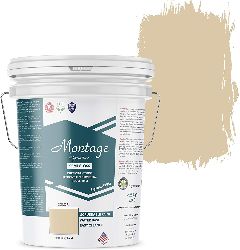 Montage Signature Paints make the above product.
Montage Signature Paints make the above product.
It is one of the leading manufacturers of eco-friendly upcycled paint brands.
They are clearly in the good books of environmental conservation organizations.
The company offers exterior, interior, residential, and industrial paints.
They are renowned for producing cheap but high-quality paint products.
Painters prefer the paint mentioned above for the following reasons:
- It is versatile: you can use it on exterior/interior surfaces, commercial and small-scale projects
- The paint comes in many colors and shades, giving you the liberty to choose your taste
- Montage Signature paint is easy to spread and clean off its spills, and the painting equipment
- This paint is sold in one-gallon cans
- It has excellent surface coverage and substrate protection
3. INSL-X Fire Retardant Paint
The above latex paint is produced by INSL-X®, owned by Benjamin Moore & Co., headquartered in Montvale, New Jersey.
The company prides itself on industrial, specialty, and architectural coatings, primers, paints, and coatings.
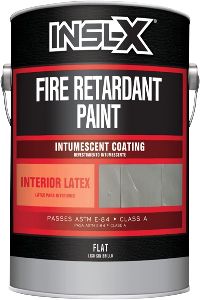 Their products contain low amounts of chemicals, making for an excellent scorecard in the toxicity and eco-friendly index.
Their products contain low amounts of chemicals, making for an excellent scorecard in the toxicity and eco-friendly index.
The product in question is made explicitly for use on fire-prone substrates.
It is formulated with intumescent agents to arrest fire spread.
Other advantages and desirable features of the said paint are:
- It is packed in one-gallon cans
- This paint is perfect for indoor use, i.e., on tables, beds, interior doors, and furniture.
- The paint is low in VOC; therefore, it’s safe for human health and the environment.
- INSL-X retails at an affordable price
- It has decent coverage of 150 square feet per gallon
- It gives a decorative flat finish
4. Majic Paints 8-0048 Latex Flat Barn & Fence Paint
Majic Paints make this paint. The company has manufactured paints since 1920, so they abound with experience in these realms.
Their extensive repository comprises oil paints, acrylics, spray paints, latex paints, and wood finishing products.
They also manufacture a variety of home, farm, industrial, and specialty products.
Its range of products is so vast that they have an in-house marketing branch to streamline its operations.
Their latex barn and fence paint have the following upsides and qualities:
- It comes in one-gallon cans.
- The paint is richly-pigmented and provides excellent color retention
- It is meant for exterior use
- This paint is laced with vermin-proof and termite repellents to prevent pest attacks.
- Majic latex barn and fence paint have wide surface coverage of up to 250 square feet per gallon.
- It is easy to use and clean.
Conclusion
To conclude, paints have come a long way to be the present-day perfect protective and decorative coatings.
There is great diversity in types, and the ‘paint’ tag has become an umbrella term.
It necessitates the need to know paint types before making a purchase. The above content addresses
Acrylic vs Latex Paint
As depicted in the article, the paints have similarities and differences in several facets.
The two are among the most common paints worldwide.
To put their popularity into perspective, all households have two or more items painted with either latex or acrylic paint! Isn’t that impressive?
It’s quite telling of their delivery and efficiency.
The similarities involve their solvent, thinning agent, longevity, and adjunct constituents.
The differences are in durability, costs, active ingredients, adhesive characteristics, weather tolerance, etc.
I’ve already discussed most of the points in detail; I urge you to read the entire review as this part only features the summary.
Other pertinent talking points relate to the feasibility of mixing the two paints and why painters use acrylic paint.
I’ve expounded on these, too; just scroll up to find out more.
I’ve capped the article by mentioning and discussing a few top-notch products for paints in question.
I urge you to purchase through the links and share the article widely.
I’m also looking forward to your feedback and questions in the comments section.
All the best in your painting endeavors.
